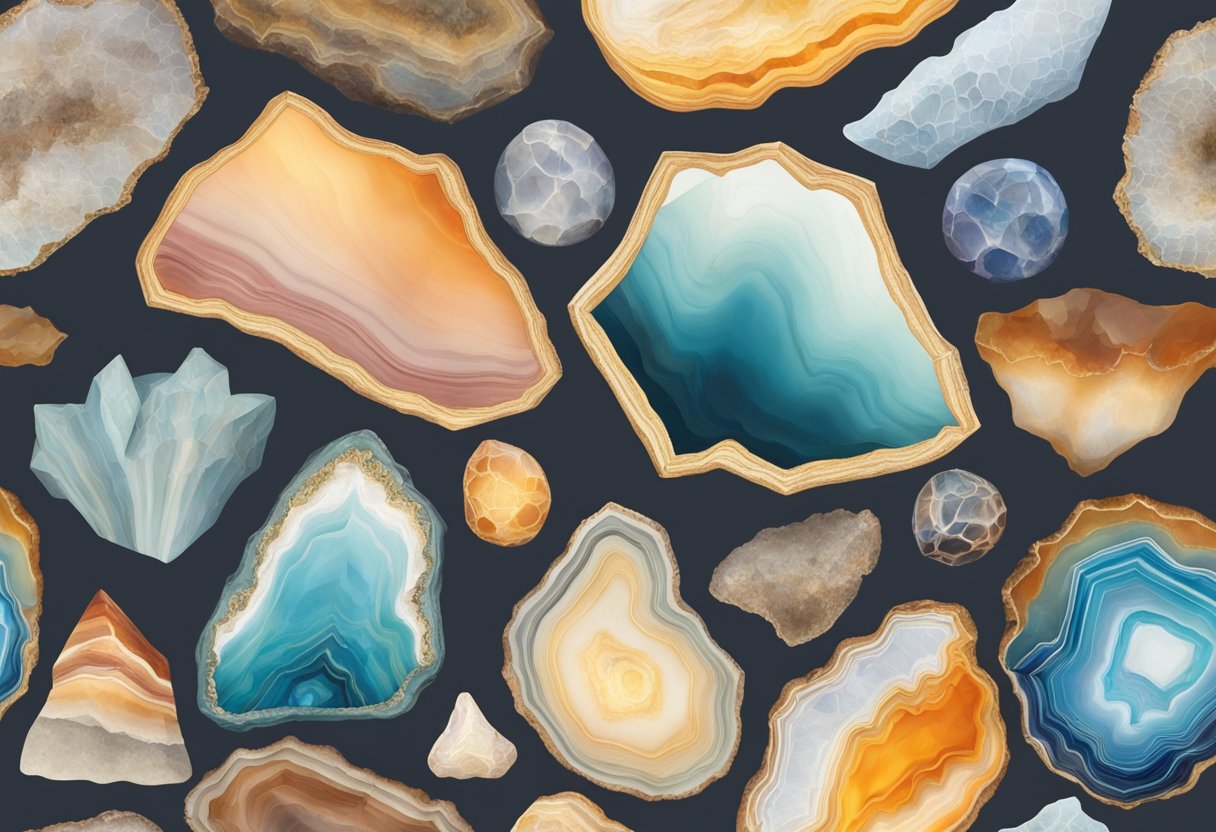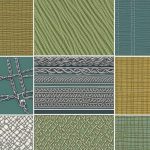Types Of Agate
Agate is a beautiful and unique variety of chalcedony that is formed from microscopic crystals of quartz. It is known for its distinctive banding patterns and wide range of colors, which make it a popular choice for jewelry and decorative objects. Agate is found in many different locations around the world, each with its own unique characteristics and qualities.
The formation and composition of agate are fascinating topics that have been studied by geologists for many years. Agates are formed when silica-rich fluids seep into cavities and cracks in rocks, where they slowly crystallize over time. The resulting agate can have a wide range of colors and patterns, depending on the minerals that are present in the surrounding rock. Agate is typically composed of microscopic crystals of quartz, but it can also contain other minerals such as calcite, pyrite, and hematite.
There are many different types of agate, each with its own unique characteristics and qualities. Some of the most popular types of agate include moss agate, which is known for its green and white banding patterns; blue lace agate, which has delicate blue and white stripes; and fire agate, which has a distinctive iridescent quality. Other types of agate include dendritic agate, fortification agate, and plume agate. Each type of agate has its own unique properties and is prized by collectors and enthusiasts around the world.
Key Takeaways
- Agate is a variety of chalcedony that is known for its distinctive banding patterns and wide range of colors.
- Agates are formed when silica-rich fluids seep into cavities and cracks in rocks, where they slowly crystallize over time.
- There are many different types of agate, each with its own unique characteristics and qualities, and they are prized by collectors and enthusiasts around the world.
Formation and Composition

How Agates Form
Agate is a type of chalcedony that forms from the deposition of silica-rich fluids in cavities or vesicles within rocks. The process of agate formation begins when silica-rich fluids, which are often derived from volcanic activity, flow through cracks or voids in the host rock. As the fluids cool and evaporate, they leave behind layers of microcrystalline quartz, forming the characteristic bands and patterns of agate.
Agates can form in a variety of host rocks, including volcanic rock and sedimentary rocks such as limestone and shale. The type of host rock and the conditions under which the agate formed can influence the color and pattern of the agate.
Agate Composition
Agate is composed primarily of microcrystalline quartz, which is a mineral made up of silicon and oxygen atoms. The quartz crystals in agate are typically small and tightly packed, giving the stone a smooth, glassy texture. In addition to quartz, agate may contain other minerals such as iron oxide, manganese oxide, and calcium carbonate, which can contribute to the stone’s color and pattern.
The composition of agate can vary depending on the location and conditions under which it formed. For example, agates from Brazil may contain more iron oxide, giving them a reddish-brown color, while agates from Mexico may contain more manganese oxide, giving them a blue-gray color.
Chalcedony and Quartz
Agate is a type of chalcedony, which is a group of microcrystalline quartz minerals. Chalcedony can occur in a variety of colors and patterns, depending on the minerals present and the conditions under which it formed. Other types of chalcedony include carnelian, jasper, and onyx.
Quartz is the most abundant mineral on Earth, and is found in a wide variety of rocks and environments. It is composed of silicon and oxygen atoms arranged in a crystal lattice structure. Quartz can occur in a variety of colors and forms, including clear, white, pink, and smoky.
In summary, agate is a type of chalcedony that forms from the deposition of silica-rich fluids in cavities or vesicles within rocks. It is composed primarily of microcrystalline quartz, and can contain other minerals such as iron oxide and manganese oxide. The type of host rock and the conditions under which the agate formed can influence its color and pattern.
Characteristics of Agates
Agates are a type of chalcedony mineral that is characterized by its banded or layered appearance. They are formed from volcanic rocks and are found in a wide range of colors and patterns. The following subsections will discuss the various characteristics of agates.
Color and Banding
Agates come in a variety of colors, including white, gray, blue, red, and yellow. The colors are often arranged in bands or layers, which give the stone its distinctive appearance. The banding can be thin or thick, and the colors can be uniform or multicolored. The banding is caused by the deposition of different minerals over time, which creates distinct layers of color.
Transparency and Inclusions
Agates can be either translucent or transparent, depending on the amount of impurities in the stone. Translucent agates allow some light to pass through, while transparent agates allow more light to pass through. Inclusions can also be present in agates, which are small particles of other minerals that are trapped inside the stone during its formation. Inclusions can add to the beauty of the stone and create unique patterns.
Physical Properties
Agates have a hardness of 6.5-7 on the Mohs scale, which makes them relatively hard and durable. They have a vitreous or waxy luster and can be polished to a high shine. Agates are also resistant to chemicals and weathering, which makes them ideal for use in jewelry and decorative objects.
In conclusion, agates are a beautiful and unique type of mineral that are prized for their distinctive appearance and durability. The banding, transparency, and physical properties of agates make them a popular choice for use in jewelry, decorative objects, and other applications.
Types of Agate
Agate is a mineral that belongs to the quartz family and is known for its unique patterns and colors. Agate can be found in various locations around the world, and each location produces a different type of agate. In this section, we will explore some of the most popular types of agate.
Banded Agate
Banded agate is one of the most popular types of agate. It is characterized by its vibrant, layered bands that can be sliced or polished. Banded agate is often used in home decor, jewelry, and art. It is believed to have healing properties and is thought to promote inner stability and composure.
Moss Agate
Moss agate is a type of agate that contains green or brown moss-like inclusions. These inclusions are created by iron or manganese oxide and are often dendritic in shape. Moss agate is believed to have healing properties and is thought to promote emotional balance and physical health.
Fire Agate
Fire agate is a type of agate that is characterized by its fiery, iridescent colors. It is formed when iron oxide and other minerals are deposited in the agate. Fire agate is believed to have healing properties and is thought to promote self-confidence and creativity.
Lace Agate
Lace agate is a type of agate that is characterized by its delicate, lacy patterns. It is often used in jewelry and is believed to have healing properties that promote emotional balance and stability.
Botswana Agate
Botswana agate is a type of agate that is found in Botswana, Africa. It is characterized by its soft, muted colors and is often used in jewelry and home decor. Botswana agate is believed to have healing properties that promote emotional balance and stability.
Other Varieties
Other popular varieties of agate include plume agate, turritella agate, crazy lace agate, polyhedroid agate, condor agate, blue lace agate, carnelian agate, fairburn agate, sagenite agate, blue agate, and agate crystal. Each variety has its unique patterns and colors and is often used in jewelry, home decor, and art.
Agate Localities
Agates are found all over the world and are often named after the locality where they were first discovered. Here are some of the most notable agate localities:
North American Agates
One of the most famous agate localities in North America is Lake Superior, which is located in Michigan. Lake Superior agates are known for their distinctive red, white, and black banding patterns. Other notable North American agate localities include Wyoming, Arizona, and New Mexico.
European Agates
Sicily is a well-known source of agates, with the town of Agate being named after the stone. Germany is also a major producer of agates, with the town of Idar-Oberstein being particularly famous for its lapidary work.
South American Agates
Uruguay is a major producer of agates, with the country’s agates being known for their bright colors and intricate banding patterns. Brazil is also a significant producer of agates, with the country’s agates being known for their large size and vivid colors.
African and Asian Agates
Agates are found in many parts of Africa, with notable localities including the Dirillo River in Sicily and India. In Asia, agates are found in countries such as Indonesia and Turkey.
Overall, agates are found in many different parts of the world and are prized for their beauty and unique banding patterns. Whether you are a collector or simply appreciate the beauty of these stones, there is no shortage of amazing agate localities to explore.
Agates in Jewelry and Decor
Agates are a popular choice for jewelry and home decor due to their unique and colorful patterns. They are often used as a gemstone in jewelry and as a decorative item in the home. Agates come in a range of colors, including purple, and are often cut into cabochons or beads for use in jewelry.
Gemstone Quality
Agates are considered an affordable gemstone and are often used in place of more expensive gemstones. They are also available in a range of trade names, such as Blue Lace Agate and Moss Agate, which refer to their unique patterns and colors. Agates are popular for their metaphysical properties, which are believed to provide emotional healing and balance.
Agate in Home Decor
Agates are also popular in home decor, often used as bookends or decorative objects. They can add a pop of color and texture to a room and are available in a range of sizes and shapes. Agate coasters are also a popular item, providing a unique and functional addition to any coffee table.
Historical and Cultural Significance
Agates have a long history of cultural and historical significance. They have been used for thousands of years for their beauty and believed healing properties. In ancient times, agates were believed to provide protection against negative energy and were often worn as talismans. They were also used in ancient Greece and Rome for their beauty and believed healing properties.
In conclusion, agates are a unique and versatile gemstone that can be used in a variety of ways. Their affordability, unique patterns, and metaphysical properties make them a popular choice for jewelry and home decor. Their cultural and historical significance also adds to their appeal.






